
Banská Štiavnica is a town in central Slovakia, in the middle of an immense caldera created by the collapse of an ancient volcano. For its size, the caldera is known as the Štiavnica Mountains. Banská Štiavnica has a population of more than 10,000. It is a completely preserved medieval town. Because of their historical value, the town and its surroundings were proclaimed by the UNESCO to be a World Heritage Site on December 11, 1993.

Esztergom is a city with county rights in northern Hungary, 46 kilometres northwest of the capital Budapest. It lies in Komárom-Esztergom County, on the right bank of the river Danube, which forms the border with Slovakia there. Esztergom was the capital of Hungary from the 10th until the mid-13th century when King Béla IV of Hungary moved the royal seat to Buda.

Tatabánya is a city with county rights of 64,305 inhabitants in northwestern Hungary, in the Central Transdanubian region. It is the capital of Komárom-Esztergom County.
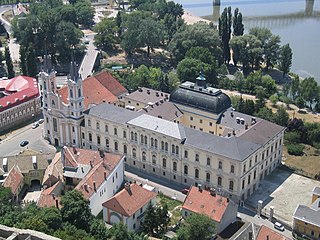
The Christian Museum is the largest ecclesiastical collection in Hungary; it conserves European and Hungarian works of art from the period between the 13th and 19th centuries.
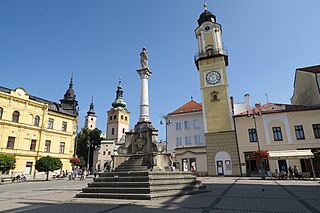
The Banská Bystrica Region is one of the eight regions of Slovakia. It is the largest of the eight regions by area, and has a lower population density than any other region. The Banská Bystrica Region was established in 1923; its borders were last adjusted in 1996. Banská Bystrica consists of 514 municipalities, 24 of which have town status. Its administrative center is the eponymous town of Banská Bystrica, which is also the region's largest town. Other important towns are Zvolen and Lučenec.
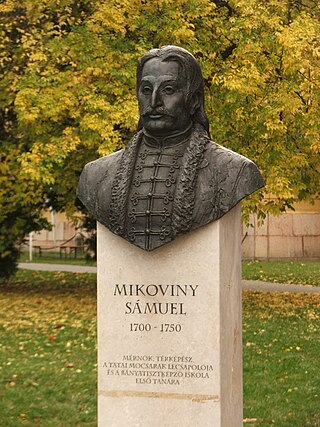
Sámuel Mikoviny was a mathematician, engineer, cartographer, and professor. He was a leading representative of science and technology in the 18th century Kingdom of Hungary and Habsburg monarchy.
Alexander (Sándor) Pituk was a Slovak and Hungarian chess problem composer and judge.

Svätý Anton is a village in Banská Štiavnica District in the Banská Bystrica Region of central Slovakia. It is situated near the historic town of Banská Štiavnica. During the period of Communist Czechoslovakia, the village had to use the name Antol as a part of anti-religious campaigns. The first mention of Svätý Anton in written sources dates to 1266, when the village was owned by the Hont-Pázmány family of the Čabraď Castle. The last private owner was Ferdinand I of Bulgaria.

The Hungarian National Gallery, was established in 1957 as the national art museum. It is located in Buda Castle in Budapest, Hungary. Its collections cover Hungarian art in all genres, including the works of many nineteenth- and twentieth-century Hungarian artists who worked in Paris and other locations in the West. The primary museum for international art in Budapest is the Museum of Fine Arts.
The architecture of Hungary is understood as the architecture of the territory of the country of Hungary, and in a wider, of the Kingdom of Hungary, from the conquest to the present day.
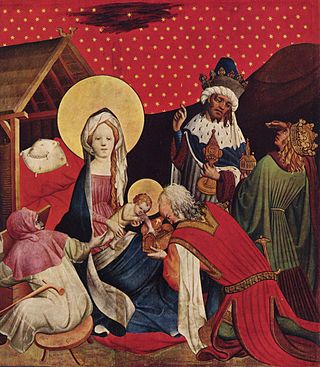
Master Francke O.P. was a North German Gothic painter and Dominican friar, born ca. 1380 in the Lower Rhine region or possibly Zutphen in the Netherlands, who died ca. 1440, probably in Hamburg, where he was based at the end of his known career. He is called "Fratre Francone Zutphanico" in one document. He may have trained as an illuminator and painter in France or the Netherlands, and later worked in Münster, before joining in St John's Priory in Hamburg by 1424 at the latest.
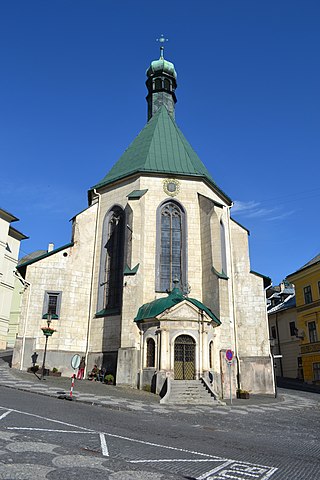
St. Catherine's Church is a Late Gothic church in the town in Banska Stiavnica, Slovakia. It is dedicated to Saint Catherine of Alexandria.
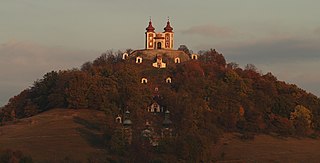
Calvary Banská Štiavnica is a late-Baroque calvary, architectural and landscape unit in Slovakia, unique in extent and content, formed in the years 1744–1751.
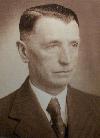
Jaroslav Augusta was a Czech-born painter and art teacher, based in Slovakia.
Sándor Jávorka was a Hungarian botanist. His birthplace was Hegybánya, then in the Kingdom of Hungary, now in Slovakia and now called Štiavnické Bane. He died in Budapest. Occasionally he has been referred to as Alexander Jávorka; the Hungarian style of his name is Jávorka Sándor.
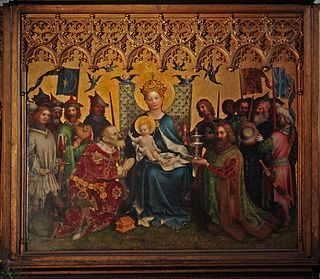
The Cologne school of painting is a term first applied in the 19th century to describe old German paintings generally. It subsequently came to refer more specifically to painters who had their workshops in medieval Cologne and the lower-Rhine region from about 1300 to 1550.
Peter W. Haas, is a Slovak art photographer. He is a member of the International Association of Art. He focuses on analogue photographing and noble techniques like platinotype, bromoil and kallitype. His pieces of art belong to collections of many dignitaries of artistic, political and business sphere in Europe, the USA, Russia and Australia.
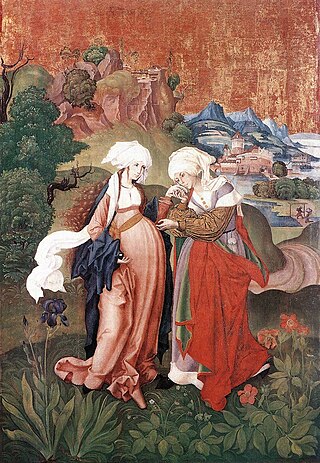
The Visitation is a 1506 panel painting by Hungarian painter known as Master MS in the collection of the Hungarian National Gallery in Budapest.

Madonna Enthroned between St. Catherine and St. Elizabeth of Hungary is an icon, a central part of the side altar of the Church of the Nativity of the Virgin Mary in Jánovciach. The author of the original triptych, Master Martin, signed his name on the back of the icon, from 1497. The signature on the back of the board reads: Martin(us) 1497 Pictor in Vigilia Nativity (is). The patron of the icon is unknown.

The St. Catherine of Alexandria Church is a Roman Catholic church in the Tabán quarter of Budapest, Hungary. It is the parish church of the Tabán Parish which also comprises parts of Gellért Hill and Naphegy. The church is a listed monument that was built in Central European Baroque style between 1728 and 1777. It was reconstructed several times in the 19th–20th centuries.




















